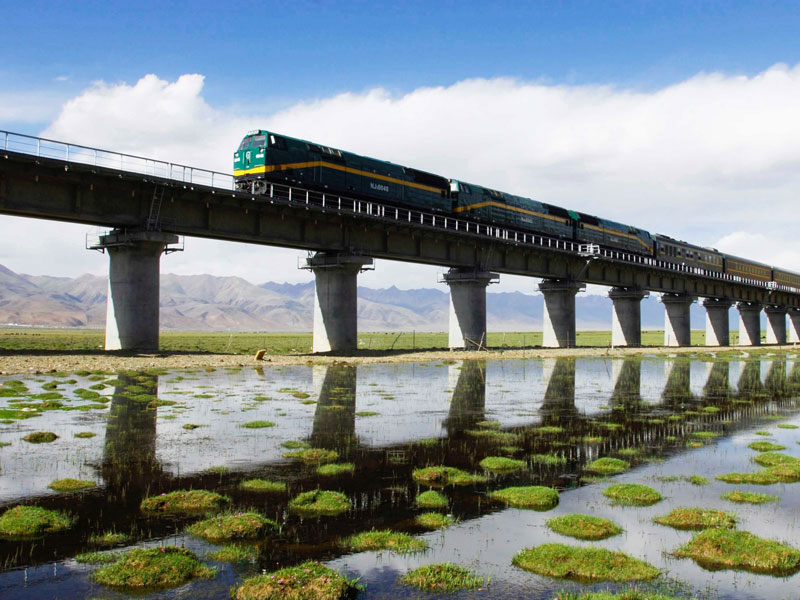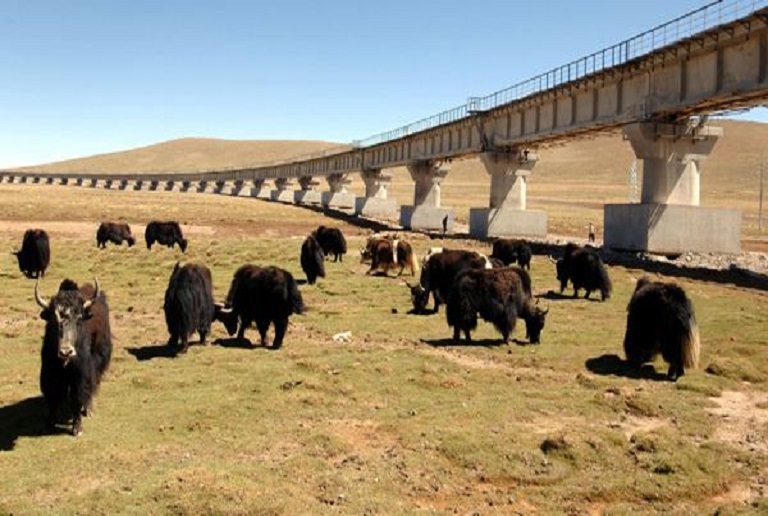“On a beautiful day, you could see various animals, zebras, gazelles, giraffes, even elephants,” Fauzia Hussein, a passenger on the Mombasa-Nairobi Railway, described the wildlife she observed along the route.
Since it opened to traffic in 2017, the Mombasa-Nairobi railway has been crossed by countless wild animals migrating between north and south, bringing a spectacle of life to the vast grasslands of East Africa, while on the Qinghai-Xizang Plateau in China, Xizang antelopes started crossing the Qinghai-Xizang Railway as early as 2006, bringing a frenzy of life to the wild and silent nature.
From the Qinghai-Xizang Railway to the Mombasa-Nairobi Railway, Chinese construction projects have made a concerted effort to avoid disrupting the flow of wildlife while supplying much needed infrastructure.
WILD LIFE CORRIDORS
Every year from May to July, Xizang antelopes, the “spirits of the plateau,” migrate for their calving season. Female antelopes in the Sanjiangyuan (Three-River-Source) area of Qinghai, in Mount Altun of Xinjiang and in Qiangtang of Xizang, gather together and travel to Zonag Lake in northwest China’s Hoh Xil (Kekexili) nature reserve.

In 2006, the Qinghai-Xizang Railway was officially open to traffic. The winding tracks across Hoh Xil has not caused any geographic separation in the nature reserve and the migration of Xizang antelopes continues year after year, thanks to the construction of dedicated corridors for wildlife.
The engineers of this line took into account the migration of wild animals such as Xizang antelopes. They therefore built 33 eco-accesses adapted to the local fauna in terms of location, width and height.
Eight years later, the same was done in the construction of the Mombasa-Nairobi Railway, an important transport link between the Kenyan port and the country’s capital.
As the railroad tracks would go through Nairobi and Tsavo National Park, the largest nature reserve in Kenya, the potential impact on wildlife and the environment was of immediate concern for local conservationists.
“During the design process … we have taken a series of targeted measures to address environmental issues by drawing on design experiences from the A50 motorway in the Netherlands, the B38 in Germany and the Qinghai-Xizang Railway in China,” said Zhang Jingqiao, chief designer of the Mombasa-Nairobi Railway.

Based on research of wildlife migration corridors, 14 crossings for large animals and 79 bridges have been constructed along the route. All bridges have a height of 6.5 meters or more, which allows giraffes to pass without having to lower their heads.
The Mombasa-Nairobi Railway allows all types of wildlife to cross the line freely. Director General of the Kenya Wildlife Service Kitili Mbathi said he searched in person along the tracks and found no negative impact on the wildlife.
ECOLOGICAL RAILWAYS
While preserving migration corridors, it is also essential to create ecological pathways, which attaches equal importance to local flora and fauna.
The Qinghai-Xizang Railway built a green path of over 700 km along the track by planting trees, bushes and grass where needed, while the Mombasa-Nairobi Railway protected the mangroves in the wetlands of Mombasa by reducing logging and burying a number of irrigation pipes to ensure the normal growth of mangroves.
The green path is based on environmental protection, so pollution abatement is key to reducing damage amid the construction and operation of railways.
As the various ecologies of the Qinghai-Xizang Plateau hold a special place in the world, the railway crossing adopted a new fully-enclosed wagon with an advanced sewage and waste collection system.

“The trains are equipped with collection devices that prevent sewage and waste from being discharged directly onto the line,” said Konchog Chodron, a conductor of China Railway Qinghai-Xizang Group Co., Ltd.
Crossing two major national parks in Kenya, the railway uses available transport corridors to reduce secondary impact on the ecosystem of nature reserve and limit the waste of land and noise pollution, said Li Changgui, general manager of China Road and Bridge Corporation Kenya Office.
ENVIRONMENTAL-FRIENDLY INFRASTRUCTURE
Praising the Mombasa-Nairobi Railway which draws on the experience of the Qinghai-Xizang Railway, Marco Lambertini, director general of the World Wide Fund for Nature International, said that Chinese companies have shown that infrastructure construction could be environmentally friendly.
From the Qinghai-Xizang Railway to that of Mombasa-Nairobi, Chinese projects have never ceased to increase environmental awareness.
Wu Xiaomin, a researcher from the Shaanxi Institute of Zoology, said that in recent years, the areas where Xizang antelopes migrate to give birth have been extended gradually, and their reproduction, habitats and migration corridors have yielded remarkable results.

“Both the fence and underpasses in Tsavo East and West National Park have effectively facilitated movement of wild animals as they look for fodder and water,” Benson Okita Ouma, head of monitoring at Save the Elephants, said about the corridors along the Mombasa-Nairobi Railway.
The hope for these infrastructure sites is for humans and nature to live in harmony, building a community of all life on Earth.
SOURCE: Sina / Xinhua, Oct. 14 , 2021
http://english.sina.com/china/s/2021-10-14/detail-iktzqtyu1465124.shtml

Watch VIDEO on protecting nature along the Mombasa-Nairobi Railway